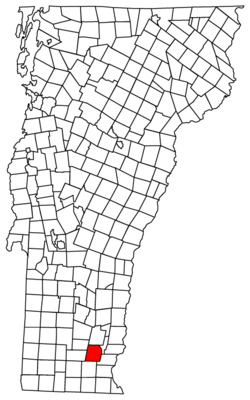Newfane, Vermont
| Newfane, Vermont | |
|---|---|
| Town | |

A church in Newfane
|
|
 Location in Vermont. |
|
| Location in the United States | |
| Coordinates: 42°59′N 72°41′W / 42.983°N 72.683°WCoordinates: 42°59′N 72°41′W / 42.983°N 72.683°W | |
| Country | United States |
| State | Vermont |
| County | Windham |
| Chartered | 1761 |
| Area | |
| • Total | 40.4 sq mi (104.6 km2) |
| • Land | 40.2 sq mi (104.2 km2) |
| • Water | 0.1 sq mi (0.4 km2) |
| Elevation | 1,004 ft (306 m) |
| Population (2010) | |
| • Total | 1,726 |
| • Density | 41.7/sq mi (16.1/km2) |
| Time zone | Eastern (EST) (UTC-5) |
| • Summer (DST) | EDT (UTC-4) |
| ZIP code | 05345 |
| Area code(s) | 802 Exchange: 365 |
| FIPS code | 50-48400 |
| GNIS feature ID | 1462159 |
Newfane is the shire town (county seat) of Windham County, Vermont, United States. The population was 1,726 at the 2010 census. The town includes the villages of Newfane, Williamsville and South Newfane.
One of the New Hampshire grants, it was chartered on June 19, 1753 by Governor Benning Wentworth, who named it Fane after John Fane, the 7th Earl of Westmoreland. But hostilities during the French and Indian War prevented its settlement. Because a first town meeting was not held within the required five years, the charter was deemed null and void. So Wentworth issued an entirely new charter on November 3, 1761 as New Fane. The town was settled in 1766 by families from Worcester County, Massachusetts. Newfane became the shire town of the county before 1812. Atop Newfane Hill, they built a village, including the county buildings. Because of winter travel difficulties, however, it was relocated to the flatland below in 1825, until 1882 called Fayetteville after the Marquis de Lafayette.
The town has a diversified terrain, with both high hills and deep valleys. Farmers found good soil for cultivation on the intervales, and for grazing on the uplands. Various streams provided water power for mills, and by 1859 industries included manufacturers of both leather and linseed oil, two flour mills, two lumber mills, and a large carriage factory. As a result, Newfane became prosperous during the 19th-century, when it built the Federal, Greek Revival and Victorian architecture that today makes it a favorite tourist destination.
...
Wikipedia

